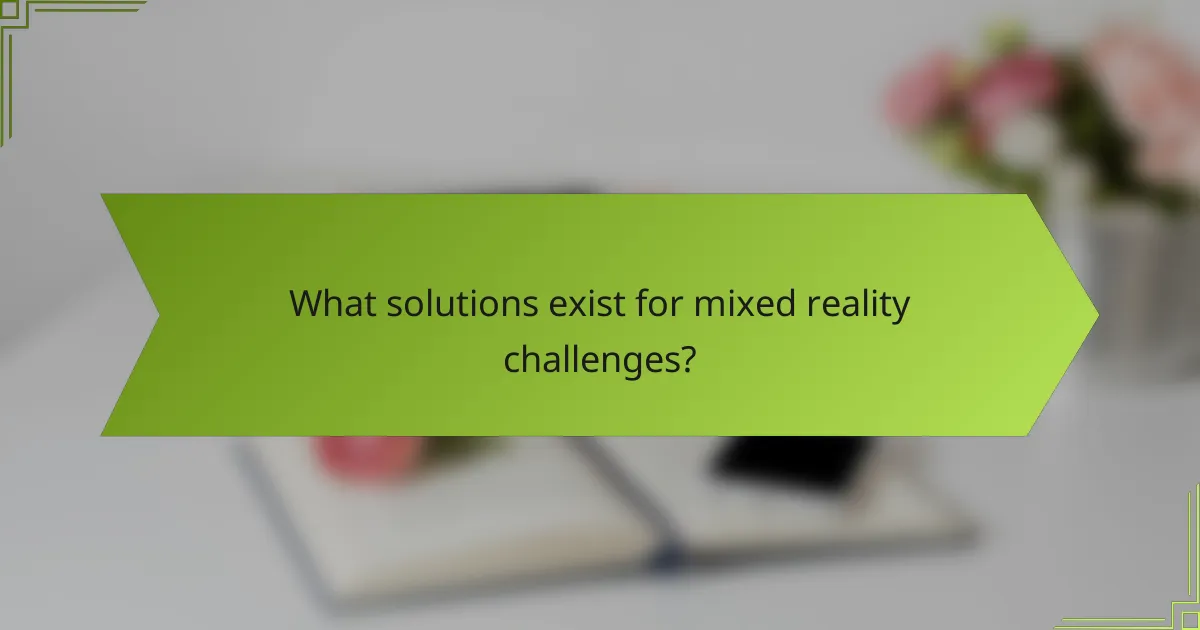Mixed reality (MR) presents unique challenges that can impede its successful adoption, including technical limitations, user experience hurdles, and content creation complexities. To overcome these obstacles, businesses can employ targeted solutions that enhance hardware and software capabilities, foster collaboration, and prioritize user training. By setting clear objectives and utilizing pilot projects, organizations can tailor MR implementations to their specific needs, ultimately unlocking its full potential and delivering significant benefits.

What are the key challenges in mixed reality?
Mixed reality (MR) faces several key challenges that can hinder its effective implementation and user adoption. These challenges include technical limitations, user experience issues, content creation difficulties, integration with existing systems, and cost barriers.
Technical limitations
Technical limitations in mixed reality often stem from hardware constraints, such as processing power, battery life, and display quality. Devices may struggle to render high-quality graphics in real-time, leading to latency issues that disrupt the user experience.
Additionally, the accuracy of motion tracking and environmental mapping can vary significantly between devices. Users may encounter problems with spatial awareness and object recognition, which can diminish the immersive experience.
User experience issues
User experience in mixed reality can be compromised by factors like interface complexity and physical discomfort. Users may find it challenging to navigate MR environments if interfaces are not intuitive or if they require extensive training.
Physical discomfort, such as eye strain or motion sickness, can also deter users from engaging with MR applications. Ensuring that content is designed with user comfort in mind is crucial for long-term adoption.
Content creation difficulties
Creating content for mixed reality can be resource-intensive and requires specialized skills. Developers must consider various factors, such as 3D modeling, animation, and interactivity, which can complicate the content creation process.
Moreover, the need for high-quality assets that are optimized for different devices adds another layer of complexity. This can lead to longer development times and increased costs, making it challenging for smaller teams to produce MR content.
Integration with existing systems
Integrating mixed reality solutions with existing systems can pose significant challenges, particularly in industries with established workflows. Compatibility issues may arise when trying to connect MR applications with legacy software or hardware.
Organizations must carefully assess their current infrastructure and determine how MR can enhance or disrupt existing processes. A clear integration strategy is essential to ensure a seamless transition and maximize the benefits of mixed reality.
Cost barriers
The cost of implementing mixed reality solutions can be a major barrier for many organizations. Expenses can include hardware purchases, software development, and ongoing maintenance, which may exceed initial budgets.
To mitigate these costs, businesses should evaluate the potential return on investment (ROI) of MR applications. Prioritizing projects that demonstrate clear value can help justify the expenses and encourage further investment in mixed reality technologies.

What solutions exist for mixed reality challenges?
Several solutions address mixed reality challenges, focusing on hardware, software, collaboration, and user training. These strategies aim to enhance user experience, improve content creation, and streamline deployment processes.
Enhanced hardware development
Advancements in hardware are crucial for overcoming mixed reality challenges. Improved processing power, better sensors, and lighter devices enhance the overall user experience. For instance, headsets with higher resolution displays and lower latency can significantly reduce motion sickness and increase immersion.
When selecting hardware, consider factors like battery life, weight, and compatibility with existing systems. Investing in devices that support the latest standards, such as 5G connectivity, can also future-proof your mixed reality applications.
Improved software platforms
Software platforms play a vital role in addressing mixed reality challenges by providing robust tools for development and deployment. Platforms like Unity and Unreal Engine offer extensive libraries and support for creating immersive experiences. These tools can streamline the development process and reduce time to market.
It’s essential to choose software that aligns with your project goals and target audience. Look for platforms that offer cross-device compatibility and support for various operating systems to maximize reach and usability.
Collaboration tools for content creators
Collaboration tools are essential for content creators working in mixed reality environments. Platforms like Microsoft Teams and Slack facilitate real-time communication and project management, allowing teams to share ideas and feedback efficiently. Using shared virtual spaces can enhance collaboration by enabling team members to interact with 3D models and simulations.
Consider integrating tools that support version control and asset management to streamline workflows. This can help prevent conflicts and ensure that all team members are working with the most current assets and information.
Training programs for users
Effective training programs are critical for users to fully leverage mixed reality technologies. These programs should focus on hands-on experience and practical applications, helping users become comfortable with the technology. Workshops and online courses can provide structured learning paths tailored to different skill levels.
When designing training programs, incorporate feedback mechanisms to assess user understanding and adapt content accordingly. Providing ongoing support and resources can also help users stay updated with new features and best practices in mixed reality applications.

How can businesses implement mixed reality effectively?
Businesses can implement mixed reality effectively by establishing clear goals, testing concepts through pilot projects, training users, and incorporating feedback. These steps ensure that mixed reality solutions are tailored to specific needs and can deliver tangible benefits.
Define clear objectives
Setting clear objectives is crucial for successful mixed reality implementation. Businesses should identify specific problems they aim to solve or enhancements they wish to achieve, such as improving training efficiency or enhancing customer engagement.
Objectives should be measurable and aligned with overall business goals. For example, a company might aim to reduce training time by 30% or increase customer interaction rates by 20% through mixed reality applications.
Conduct pilot projects
Pilot projects allow businesses to test mixed reality solutions on a smaller scale before full deployment. These trials help identify potential challenges and assess the technology’s effectiveness in real-world scenarios.
When conducting pilot projects, it’s essential to choose a representative sample of users and gather data on performance metrics. This approach can help refine the solution and ensure it meets the defined objectives.
Invest in user training
User training is vital for maximizing the benefits of mixed reality technologies. Employees must understand how to use the tools effectively to ensure smooth adoption and integration into existing workflows.
Training programs should be tailored to the specific mixed reality applications being implemented. Consider offering hands-on workshops or online tutorials to accommodate different learning styles and schedules.
Utilize feedback loops
Establishing feedback loops is essential for continuous improvement of mixed reality solutions. Regularly collecting input from users can highlight areas for enhancement and help address any issues promptly.
Feedback can be gathered through surveys, focus groups, or direct observations. Analyzing this data allows businesses to make informed adjustments and ensure that the mixed reality applications evolve to meet user needs effectively.

What strategies enhance user engagement in mixed reality?
Effective strategies to enhance user engagement in mixed reality (MR) include personalization, gamification, and social interaction. These approaches create immersive experiences that resonate with users, encouraging longer and more meaningful interactions.
Personalization techniques
Personalization techniques in mixed reality involve tailoring experiences to individual user preferences and behaviors. This can include customizing content, adjusting difficulty levels, or modifying environments based on user input. By leveraging user data, developers can create unique experiences that feel relevant and engaging.
For example, a fitness app in MR might adjust workout routines based on a user’s fitness level or preferences, ensuring that the experience remains challenging yet achievable. Utilizing user feedback and analytics can help refine these personalized elements over time.
Gamification elements
Gamification elements enhance user engagement by incorporating game-like features into mixed reality experiences. This can include rewards, challenges, and leaderboards that motivate users to participate actively. By adding these elements, developers can transform mundane tasks into exciting challenges.
For instance, an educational MR application might reward users with points for completing tasks or achieving milestones, fostering a sense of accomplishment and encouraging continued use. Balancing difficulty and reward is crucial to maintain user interest without causing frustration.
Social interaction features
Social interaction features in mixed reality allow users to connect and collaborate with others, significantly boosting engagement. These features can include multiplayer modes, shared experiences, and communication tools that enable users to interact in real-time. Facilitating social connections can make experiences more enjoyable and memorable.
For example, a virtual reality game might allow players to team up with friends or compete against others, creating a sense of community. Developers should consider implementing features that encourage collaboration and competition, as these can enhance user satisfaction and retention.

What best practices should be followed in mixed reality development?
Best practices in mixed reality development focus on creating immersive, user-friendly experiences while ensuring compatibility across various platforms. Prioritizing user needs and technical adaptability can significantly enhance the effectiveness and reach of mixed reality applications.
Focus on user-centered design
User-centered design is essential in mixed reality development as it prioritizes the needs, preferences, and limitations of end-users. Engaging users early in the design process through feedback sessions and usability testing can help identify pain points and improve overall experience.
Consider creating user personas to represent different segments of your audience. This approach allows developers to tailor features and interactions that resonate with specific user groups, enhancing engagement and satisfaction.
Ensure cross-platform compatibility
Cross-platform compatibility is crucial for reaching a wider audience in mixed reality. Developers should aim to create applications that function seamlessly across various devices, such as smartphones, tablets, and dedicated headsets.
Utilizing frameworks like Unity or Unreal Engine can facilitate this process, as they support multiple platforms. Regularly testing on different devices and operating systems helps identify compatibility issues early, ensuring a smoother user experience.
